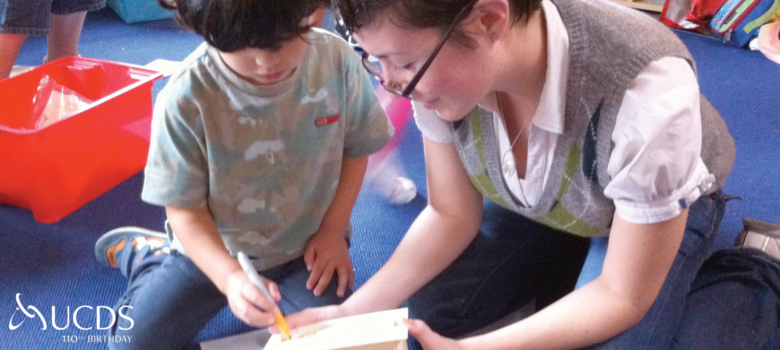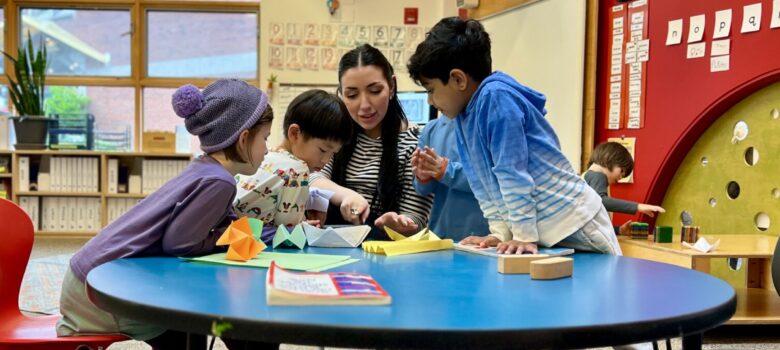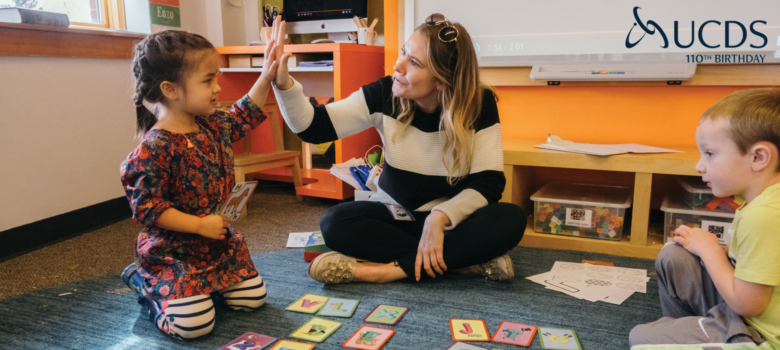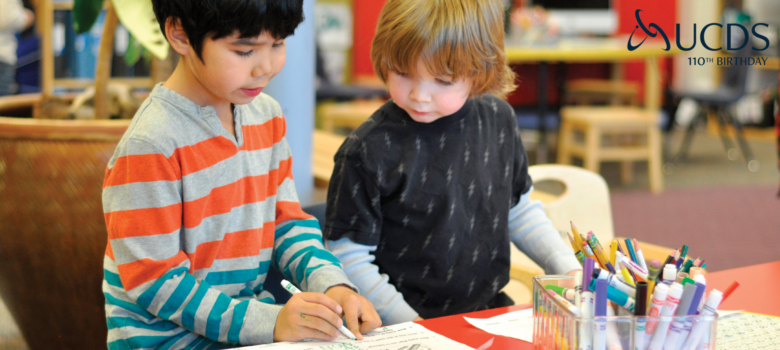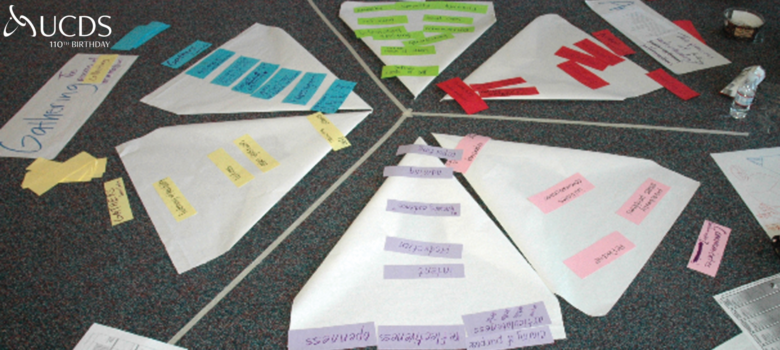UCDS is having a birthday! As we celebrate our 110th year, we are rolling back the clock and re-sharing six highlights of an innovative school: Culture of Inquiry, Sticky Curriculum, Authentic Assessment, Teacher Mentorship through Collaboration, Coaching Independence, and Being Brave. Over the next six weeks, we’ll revisit some in-depth reflections from UCDS Spark Magazine. You can also read full archived content of Spark Magazine at: https://issuu.com/ucds
Mentorship Through Collaboration: The Resident Teacher Program’s Evolution and Practice
by Julie Kalmus and Diane Chickadel
UCDS Spark
Issue #8, Fall 2010
For the past fifteen years, UCDS has welcomed over 120 teachers to join its Resident Teacher Program. Over the years, many keep in touch, sending stories about the impact that a year of teaching at UCDS had on their professional lives.
Sitting on a 400 acre winery in Napa, a surprise reunion occurs between a past Resident and current UCDS teacher. She is now running her family’s business and expecting her first child. Five years has passed since her time at UCDS and touring the beautiful vineyards, one can’t help but marvel at the quality of the collaborations and energy between her and the winery staff, “I can trace it back to my Resident year,” she offers, “one of the best things I took away from the program was the idea that I should always be thinking about how I can influence those around me to be their best selves and how I should be too.”
Days later, a different Resident writes. She is in graduate school now and hungry to have her own classroom. Several years out of the program, she reflects, “It’s funny, a lot of grad school is about how to fix problems and meet standards. To be clear, these are good things to think about. But I know that I don’t just want to fix problems for kids. I want us to build solutions together. I know what kind of teacher I am going to be and it means so much to know what that feels like and means while I digest all of this pedagogy and philosophy.”
Through the Resident Teacher Program, UCDS has been working to refine a unique immersion experience for beginning teachers that is symbiotic with the experienced teachers they work beside. Since its inception, the UCDS Resident Program has sought to model exceptional team collaborations for its students while asking, What is the impact on new teachers of doing real work in education beside an invested mentor with targeted professional development and a cohort of peers?
The journey started when UCDS recognized that purposeful, continuing professional support and collaboration amongst its faculty directly impacted the quality of student life. To this end, it looked to recreate and invigorate a traditional teacher assistant program. Because of the inherent hierarchy and lack of consistency, this type of program often felt like an afterthought. The school had some wonderful assistants over the years to be sure but the quality of their work often seemed a reflection of the quality of their personality, as opposed to the school’s support of their work.
Looking back, the school knew that new teachers had so much to offer- energy, enthusiasm, new ideas, new questions and different perspectives. Was there a way to redesign the “teaching assistant” program that would give new teachers practical experience while giving the school the benefits of more eyes and minds on individual students? It was time to try something new, something more intentional.
We looked to other professions for models that gave beginning professionals an opportunity to partner with more experienced colleagues in purposeful ways. Many of the experiences and structures that made medical residencies work for beginning doctors seemed like they could be applied to teaching residencies for beginning educators. In 1996, the school decided to capitalize on its culture of collaboration and innovation to create a new Resident Teacher Program.
With the change in name came a change in culture. It began by looking at hiring, professional development, partnership and Mentorship in new ways. Instead of hiring people who were interested in being “assistants,” the school aimed to hire people who were deeply interested in education and children and partnered them with Mentors who would collaborate and teach beside them, not assign them tasks to perform. Further, to support Residents as they entered a new community and partnership and to support mentor teachers as they developed their skills as partners and Mentors, the school also created a Resident Program Coordinator position. In 1996, the school hired its first Resident Teacher and launched the program.
The following year, the first cohort of Resident Teachers was hired to work with the Early Elementary students and faculty. As the program blossomed, ownership and investment grew across the school. Established faculty discussed the value of Mentorship and collaboration and within a five year period, the Resident program grew to include Resident Teachers that worked with each level at the school. Currently, the school employs ten new Residents each year.
From the first day of employment, Residents are welcomed as full faculty members. Each Resident works in one to three classrooms, sits on a faculty committee, participates in all curriculum planning and professional development, facilitates large and small group teaching, plans and leads parent conferences and writes student reports. For Mentors, Mentorship has become about listening to ideas, sharing ideas and building classrooms and curriculum together. The expectation for Residents to do the same demands that each one engage more deeply in both the development of ideas and the practice of their work with students. The model showcases a different depth, pace and expectation than student teaching or an assistant position could offer.
Over the years, the most exciting consequence of the new model was the least expected. Teaching has changed. To truly collaborate, Mentors and Residents have to have regular conversations about individual students and the class as a whole. The fruits of these conversations lead to more targeted work with individuals, more consistency and follow through in classroom culture and greater depth and cohesiveness in curriculum planning and delivery.
On top of the in-class and after school (and often, before school) conversations that Residents have with their teaching teams, they are also a part of a peer cohort of Residents that share similar experiences. The cohort meets three times a month during the school day with the Resident Coordinators to support professional development and a broader understanding of and investment in school culture. Meeting together as peers provides an opportunity to reflect, share strategies and successes and ask questions.
Once a month, Mentors meet as a group as well to discuss ways to support Residents. Over time, patterns in conversation paralleled both groups in interesting ways. When Residents were interested in classroom management and how to find the “right” way to jump into tricky situations, Mentors were interested in how to bring language to the “right” ways that they jumped in and share that knowledge with Residents. When parent conferences were on the horizon, both Residents and Mentors wanted shared voices contributing to the dialogue with parents. Curriculum design, report writing and group facilitation all fell into similar alignment. The school also created informal and formal professional development structures to support understanding and success around these topics.
It is not always easy. You cannot just ask someone to be a mentor or mentee and expect it to be a perfect marriage. True partnership takes time and effort. It builds itself over conversation, generation, experimentation, laughter and trust. Open communication, flexibility, a strong work ethic, an ability to self-advocate, a true passion for children, high expectations and a good sense of humor have risen as critical qualities for both Mentors and Residents to share. As the school recruits new Residents each year, these are all qualities it seeks.
Culturally, the school has continued to recommit itself to the importance of welcoming new Resident faculty each year onto the team. It forces everyone in the community to rearticulate our philosophy, beliefs and approach and requires each team to build community and curricular programs anew. This collaboration is the energy that ignites the excitement and interest of faculty, students and their families as they enter the school’s doors each day. In this model, Mentorship is a partnership that allows each Resident to “influence those around me (them) to be their best selves” and identify “what kind of teacher I am going to be.”

